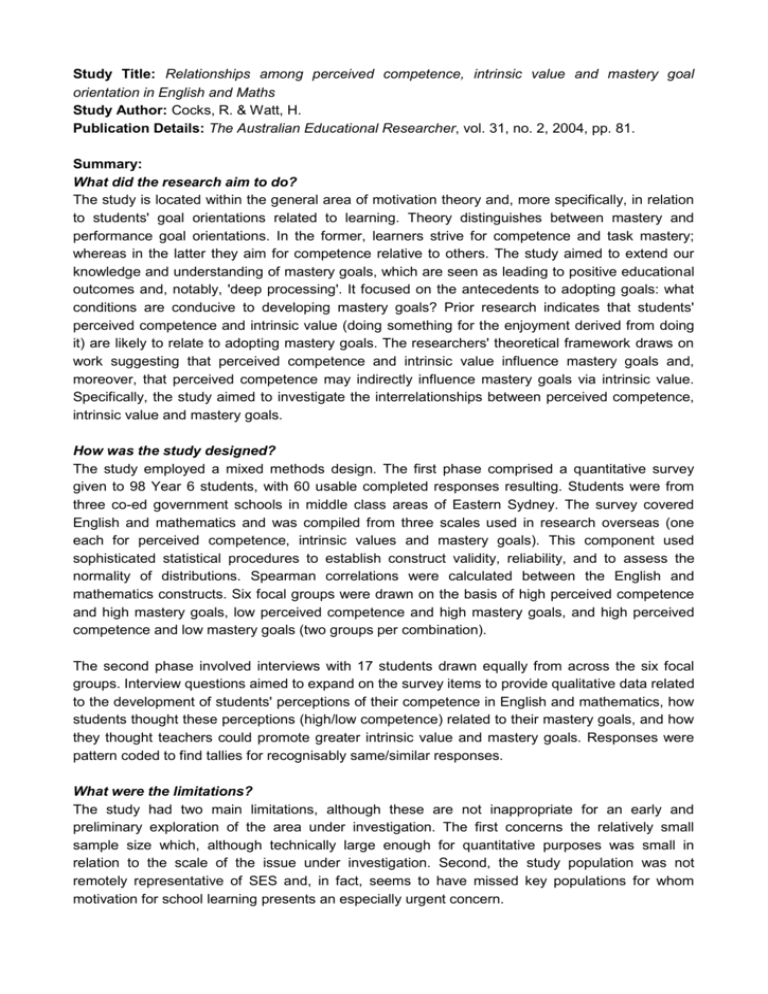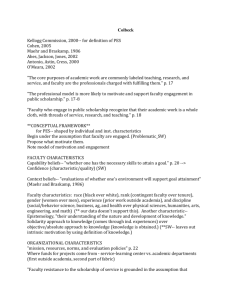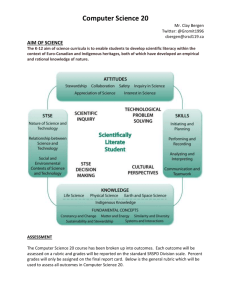Relationships among perceived competence, intrinsic value and
advertisement

Study Title: Relationships among perceived competence, intrinsic value and mastery goal orientation in English and Maths Study Author: Cocks, R. & Watt, H. Publication Details: The Australian Educational Researcher, vol. 31, no. 2, 2004, pp. 81. Summary: What did the research aim to do? The study is located within the general area of motivation theory and, more specifically, in relation to students' goal orientations related to learning. Theory distinguishes between mastery and performance goal orientations. In the former, learners strive for competence and task mastery; whereas in the latter they aim for competence relative to others. The study aimed to extend our knowledge and understanding of mastery goals, which are seen as leading to positive educational outcomes and, notably, 'deep processing'. It focused on the antecedents to adopting goals: what conditions are conducive to developing mastery goals? Prior research indicates that students' perceived competence and intrinsic value (doing something for the enjoyment derived from doing it) are likely to relate to adopting mastery goals. The researchers' theoretical framework draws on work suggesting that perceived competence and intrinsic value influence mastery goals and, moreover, that perceived competence may indirectly influence mastery goals via intrinsic value. Specifically, the study aimed to investigate the interrelationships between perceived competence, intrinsic value and mastery goals. How was the study designed? The study employed a mixed methods design. The first phase comprised a quantitative survey given to 98 Year 6 students, with 60 usable completed responses resulting. Students were from three co-ed government schools in middle class areas of Eastern Sydney. The survey covered English and mathematics and was compiled from three scales used in research overseas (one each for perceived competence, intrinsic values and mastery goals). This component used sophisticated statistical procedures to establish construct validity, reliability, and to assess the normality of distributions. Spearman correlations were calculated between the English and mathematics constructs. Six focal groups were drawn on the basis of high perceived competence and high mastery goals, low perceived competence and high mastery goals, and high perceived competence and low mastery goals (two groups per combination). The second phase involved interviews with 17 students drawn equally from across the six focal groups. Interview questions aimed to expand on the survey items to provide qualitative data related to the development of students' perceptions of their competence in English and mathematics, how students thought these perceptions (high/low competence) related to their mastery goals, and how they thought teachers could promote greater intrinsic value and mastery goals. Responses were pattern coded to find tallies for recognisably same/similar responses. What were the limitations? The study had two main limitations, although these are not inappropriate for an early and preliminary exploration of the area under investigation. The first concerns the relatively small sample size which, although technically large enough for quantitative purposes was small in relation to the scale of the issue under investigation. Second, the study population was not remotely representative of SES and, in fact, seems to have missed key populations for whom motivation for school learning presents an especially urgent concern. What were the findings? Statistically significant correlations at the p <0.05 level of confidence were found between perceived competence and intrinsic value for English, perceived competence for English and perceived competence/intrinsic value for mathematics, mastery goals for English and perceived competence/intrinsic value for mathematics, mastery goals for English and mastery goals for mathematics, and intrinsic value for English and mastery goals for mathematics. The correlation between mastery goals for English and for mathematics was strong, but all other correlations were moderate. The researchers were surprised to find little evidence for a relationship between perceived competence and mastery goals. The evidence from this study was that neither perceived competence nor intrinsic value related to the adoption of mastery goals. On the other hand, the strong correlation between mastery goals in English and mathematics is evidence for the belief that mastery goals may be consistent across academic domains and reflect a general orientation toward learning. The qualitative interview data indicated that students with high self-perceptions of competence and high mastery goals liked the subject in question, and received positive feedback from significant others. Comparisons provided the main motivating factor here: wanting to keep up with the high achievers in the class or to improve one's personal best. Students with low self-perceptions of competence and high mastery goals mentioned feelings of dislike for the subject associated with negative comments or insults from parents or peers. At the same time, these negations provided the motivation to do better. Students with high perceptions of competence and low mastery goals said they liked the subject because they were good at it, but had low intrinsic motivation to do more because of lack of teacher feedback, and/or lack of challenge and being extended in the subject. Repetitive and boring class work was robbing their interest in the subject. What conclusions were drawn from the research? Analysis of interview data indicated that normative assessment procedures used in mathematics may lead to the entwining of competence evaluation and affect at Year 6 level. By contrast, criterion-based assessment, which is common in English, may lead to competence perceptions developing less conjointly with intrinsic values. In contrast to the mediation model suggested by Harter and colleagues, patterns of relationships among the three sets of scales used in the survey suggest that neither perceived competence nor intrinsic value related to mastery goals. However, interview data suggested some variations within subgroups with respect to relationships between the key constructs. For example, data from the high perceived competence/high mastery goals subgroup seemed to endorse the expectation that high competence would generate high intrinsic value and lead to high mastery goals. By contrast, the low perceived competence/high mastery goals subgroup puts the weight on extrinsic motivation not to remain incompetent on a task or within an area. And the data from high competence/low mastery goals subgroup put the weight on there being a suitable degree of challenge and a feeling for the need to improve. The authors noted the need for further research in the area. What are the implications of the study? The authors identified five main implications from their study, in the form of actions that can be taken to help enhance students' self-perceptions of competence and mastery goals for learning: It is important for teachers (and other relevant educational agents) to provide students with genuine and constructive feedback about their competencies. It is important for students to develop appropriate individual learning aspirations rather than striving to outperform others. There is a need to provide stimulating, challenging, and realistic learning goals for all ability levels in a class, so that students are neither continually failing to the point where they come to believe they can never attain particular learning tasks, nor stripped of motivation and challenge by being asked to endlessly repeat things they can do. The teacher is responsible for minimising humiliation that can arise from poor performance, and the impression that some students might develop that they do not need to learn any more. Parents can play an important role in encouraging their children in learning and encouraging them to encourage their peers in learning. Generalisability and significance for Queensland There is no strong basis for generalisability, although the call for further research is well taken. If such research were conducted in Queensland it would be necessary to broaden the SES range of participants to gain an appropriate degree of diversity and complexity for the Queensland scene. Where can interested readers find out more? Eccles, J. S. & Wigfield, A. 1995, ‘In the mind of the actor: The structure of adolescents’ achievement task values and expectancy-related beliefs’, Personality and Social Psychology Bulletin, vol. 21, pp. 215-25. Harter, S., Whitesell, N. R. & Kowalski, P. 1992, ‘Individual differences in the effects of educational transitions on young adolescents’ perceptions of competence and motivational orientation’, American Educational Research Journal, vol. 29, pp. 777-807. Keywords: motivation, achievement, self-esteem, pedagogy, adolescents, mathematics, english








